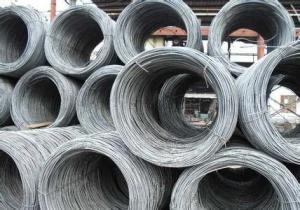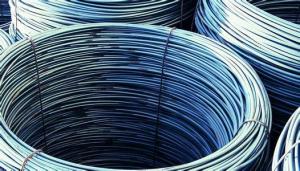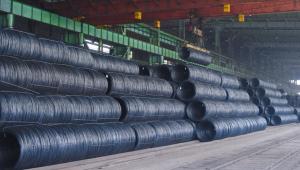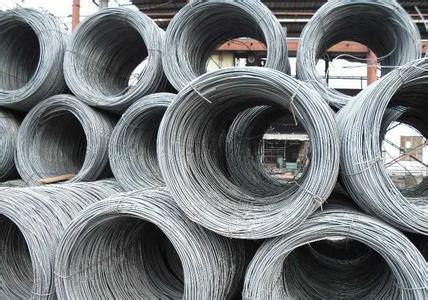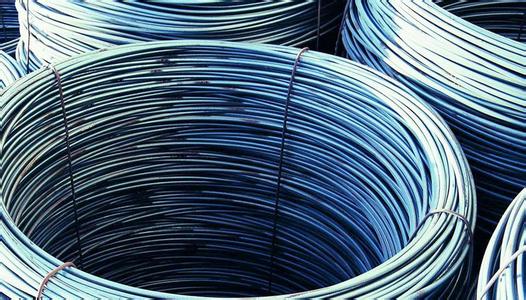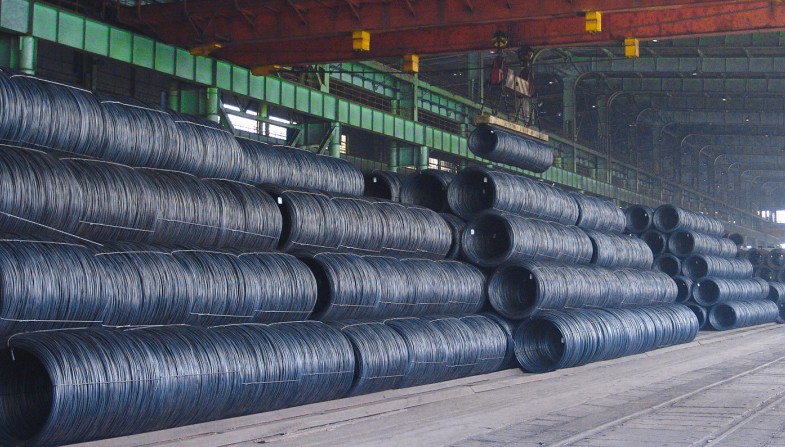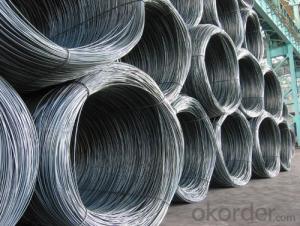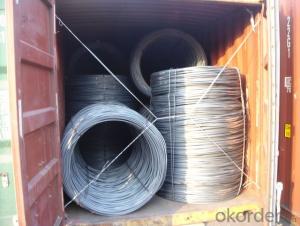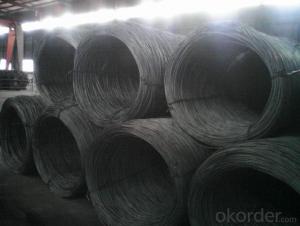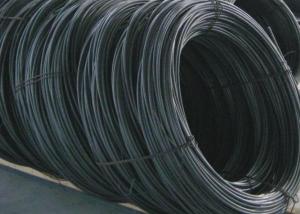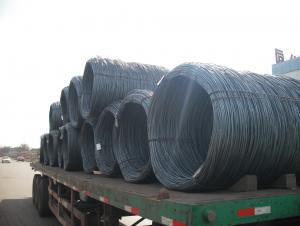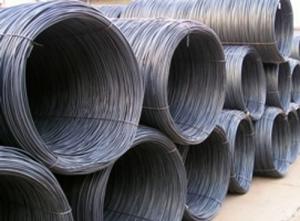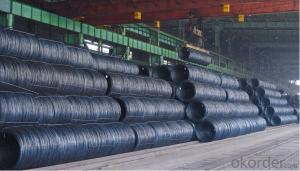Hot- rolled wire rod
- Loading Port:
- China Main Port
- Payment Terms:
- TT OR LC
- Min Order Qty:
- -
- Supply Capability:
- -
OKorder Service Pledge
OKorder Financial Service
You Might Also Like
Wire is 5-22 mm diameter hot rolled round steel, or rather the cross section of special-shaped steel. Due to the delivery of the goods in the form of wire rod, so it is also known as wire rod. Wire cross-section circumference is small, common specifications for 5-13 mm diameter. According to the different can be divided into the high speed wire rod mill (line) and ordinary wire line (at) two kinds.
classification
Generally made from ordinary carbon steel and high quality carbon steel wire rod. According to the directory and USES different steel distribution, mild steel wire including ordinary hot rolled plate, the high quality carbon steel wire rod, carbon electrode wire rod, conditioning threaded rod, wire rope with wire rod, piano wire with wire rod and stainless steel wire rod, etc.
1. Ordinary low carbon steel hot rolled plate (GB701-65), normal low carbon steel hot rolled plate by low carbon ordinary carbon structural steel or the carbon structural steel rolling of low yield point, is dosage the biggest, the most widely used in varieties of wire rod, also known as the cord.
Main use: general line is mainly used in construction of reinforced concrete structure for reinforcement, can also be made steel wire, cold drawn to pull for strapping, etc.
2. Ordinary no twist accused of cold, hot rolled low carbon steel wire rod (ZBH4403-88), no twist accused of cold, hot-rolled wire rod by no twist to control cooling after rolling in high speed wire-rod mill, material is the same as the general line, but no twist accused of cold, hot-rolled wire rod with high dimensional accuracy, good surface quality and higher mechanical properties, etc.
Main application: no twist accuracy of cold, hot-rolled wire rod size control points A, B, C level 3. A, B, C level precision is applicable to drawing, construction, packaging and electrode and other purposes, B, C level accuracy is suitable for processing into bolts, screws and nuts, etc.
3. Quality carbon steel wire rod (GB4354-84), high quality carbon steel wire rod is made of high quality carbon structural steel rolling. Is one dosage larger varieties of wire rod variety.
Main application: high quality carbon steel wire rod is mainly used for processing and manufacturing carbon spring steel wire, oil quenching tempering carbon spring steel wire, prestressed steel wire, high strength and high quality carbon structural steel wire, galvanized steel wire, galvanized wire rope, etc.
4. Quality carbon steel no twist accused of cold, hot-rolled wire rod (ZBH44002-88), no twist accused of cold, hot-rolled wire rod quality carbon steel by the high-speed wire mill rolling with no twist, disposed of by controlled cooling after rolling. Compared with the high quality carbon steel wire rod, high dimensional accuracy, good surface quality, have higher mechanical properties.
Main USES: the main purpose is the same as the high quality carbon steel wire rod. Often used in the manufacture of carbon spring steel wire, oil quenching tempering carbon spring steel wire, prestressed steel wire, high quality carbon structural steel wire, galvanized steel wire, etc.
5. Wire rope with wire rod (YB349-64), wire rope with wire rod is one of the high quality carbon structural steel hot rolled plate.
Main application: wire rope with wire rod available 35 and 40, 45, 55, 60, 65, 70, 75, 80 and 85 steel grade high quality carbon structural steel manufacture. Chemical composition meet GB699 (high quality carbon structural steel technical conditions).
6. Wire rope with no twist accused of cold, hot-rolled wire rod (ZBH44004-88), wire rope with no twist charged with hot and cold rolled plate and with high quality carbon structural steel, in the absence of torsion wire mill rolling, controlled cooling after rolling. This rolling of wire rod, high dimensional accuracy, good surface quality, superior mechanical properties.
Main application: mainly used for drawing steel and steel strand steel wire rope.
7. Carbon electrode steel wire rod (GB3429-82), carbon electrode made by high quality carbon structural steel hot rolled low carbon steel rod.
Main application: mainly used in the manufacture of manual arc welding welding core.
8. No twist accused of cold, hot rolled carbon electrode steel wire rod (ZBH44005-88), no twist accused of cold, hot rolled carbon electrode steel wire rod is rolling on blockade twist wire mill, and made controlled cooling after rolling. Its high dimensional accuracy, good surface quality, superior performance, is a kind of high quality welding rod steel wire rod.
Main application: mainly used in the manufacture of a coated electrode steel reinforced carbon steel hot rolled plate.
9. Alloy structural steel hot-rolled wire rod (GB3077-82), alloy structural steel hot-rolled wire rod by alloy structural steel rolling material. Alloy structural steel with a total of 26 steel group, the 78 steel grades. Each manufacturer according to buyer's requirements and different USES to choose brand for production.
Main use: alloy hot rolled wire rod structure is mainly used for drawing wire, metal products and components.
10. Carbon tool steel hot-rolled wire rod (GB1298-86), carbon tool steel by high quality or high quality high carbon steel rolling. Processing performance and wear-resisting performance is good, the price is cheap.
Main USES: mainly used in drawn steel ratio and making tools, etc.
11. Alloy tool steel hot-rolled wire rod (GB1299-77)
Alloy tool steels is in chrome is joined on the matrix carbon tool steel, tungsten, molybdenum, vanadium, silicon, manganese, nickel and cobalt alloy elements and tempered steel. Compared with the carbon tool steel. It has good hardenability, small heat cracking tendency, the characteristics of high wear resistance and heat resistance. Alloy tool steel hot-rolled wire rod by 33 five steel group steel grade of alloy tool steel material and rolled. Respectively by the dalian steel, benxi steel mills and steel mills and other unit production in shaanxi province.
Main use: is suitable for measuring tool, cutting tool and cold and hot die, shock resistant, etc.
12. Spring steel hot-rolled wire rod (GB1222-84)
Spring steel is used in the manufacture of springs or other steel grade of elastic element. Springs and elastic element mainly USES the elastic degeneration absorb and store energy, alleviate vibration, shock, or make parts to complete some action for the purpose. Since it is in shock, vibration or even under the working conditions of periodic alternating stress for a long time, so the spring steel with high yield strength, especially must have higher showed (the ratio of yield strength to tensile strength) and fatigue strength of high elastic, high resistance to high temperature and corrosion resistant performance. The surface of spring steel shall also have the good quality.
Spring steel with carbon spring steel and alloy spring steel, a total of 17 brands.
Main use: spring steel hot-rolled wire rod is mainly used in the production of various USES of helical spring.
13. Ball bearing steel hot-rolled wire rod (YB9-68), referred to as "bearing steel, ball bearing steel is used in the manufacture of various types of rolling bearing ring (sleeve) and steel rolling body (the ball). Due to the particularity of its USES for bearing steel has high and even hardness and wear resistance, high elasticity and fatigue strength. Enough toughness and hardenability, at the same time in the atmospheric environment or lubricant has certain corrosion resistant ability. Some special use of the rolling bearing also require high temperature resistance, corrosion resistance, nonmagnetic, ultra-low temperature, high precision, long life and other performance. So the choice of bearing steel and steel than ordinary steel strict quality.
Bearing steel is usually refers to the high carbon chromium steel, there are also carburizing bearing steel, high carbon chromium stainless bearing steel. Commonly used in rolling bearing steel hot-rolled wire rod steel grade five.
Main use: ball bearing steel hot-rolled wire rod is mainly used in the manufacture of bearing steel ball (ball), etc.
14. Stainless steel wire rod (GB4356-84), stainless steel wire rod was organized by a variety of brand different size of stainless steel hot rolling.
Main use: stainless steel wire rod is mainly used in the manufacture of stainless steel wire, stainless spring steel wire, stainless wire upsetting and stainless steel wire. According to the main industrial USES for to distinguish, stainless steel wire rod are stainless steel and stainless acid-resistant steel wire rod.
15. Welding of stainless steel wire rod (GB4241-84), welding of stainless steel wire rod and stainless steel wire rod is different in chemical composition. In order to guarantee its excellent welding performance, improve the quality of weld, welding of stainless steel wire rod in composition marked characteristics are low carbon, phosphorus, sulfur, less toxic impurities, such as nickel, chromium content is higher.
Main application: mainly used in the manufacture of welding electrode wire and steel core.
The production process
The editor
Commonly used wire line production.
A, through the step by step the billet heating furnace heated to above 1100 degrees Celsius;
Two, heating the billet, after high pressure water descaling;
Three, into the roughing mill rolling, roughing mill for the strip plant;
Four, after roughing rolled piece into the water for cooling, in order to control its internal microstructure;
Five, leave water cooling period after entering the mill and finishing mill for further rolling;
Sixth, after finishing the shape of rolled piece formed by spinning machine spit out volume;
Seven, volume of wire forward cooled in the air cooling section;
Eight, at the end of the air cooling section, wire rod by coil unit into drum shape;
After nine, with drum shape of baling wire into the baling machine;
Ten, into the shipping department.
- Q: What are the safety requirements for steel wire rod used in ski lift wire ropes?
- The safety requirements for steel wire rod used in ski lift wire ropes are crucial to ensure the safe and reliable operation of ski lifts. These requirements are designed to minimize the risk of accidents and maintain the structural integrity of the wire ropes. Firstly, the steel wire rod used in ski lift wire ropes must meet specific material standards. It should be made from high-quality, high-strength steel that is capable of withstanding the tension and stress encountered during ski lift operations. The wire rod should adhere to international standards such as ASTM A1023/A1023M or EN 12385, which specify the minimum mechanical properties and chemical composition of the wire rod. In addition to material requirements, the wire rod must undergo rigorous testing and inspection processes. This includes non-destructive testing techniques like ultrasonic examination, magnetic particle inspection, and visual inspection to identify any defects or imperfections in the wire rod. The testing should be performed by certified and qualified personnel to ensure accuracy and reliability. Furthermore, the wire rod used in ski lift wire ropes must have a specific diameter and tolerance range to maintain the desired strength and performance. Ski lift manufacturers typically provide specifications that dictate the required diameter and tolerance for the wire rod to be used in their systems. These specifications should be followed closely to ensure compatibility and safety. It is also essential to consider the surface requirements of the wire rod. The wire rod should have a smooth and clean surface, free from any burrs, cracks, or other surface defects that could compromise the structural integrity of the ski lift wire ropes. Any surface irregularities should be addressed through appropriate surface treatments or inspections. Lastly, regular maintenance and inspection of the ski lift wire ropes are necessary to ensure ongoing safety. This includes visual inspections, lubrication, and tension checks to detect any signs of wear, corrosion, or fatigue. If any issues are identified, immediate action should be taken to repair or replace the affected wire ropes to prevent accidents or failures. Overall, the safety requirements for steel wire rod used in ski lift wire ropes encompass material standards, testing, dimensional specifications, surface quality, and ongoing maintenance. Adhering to these requirements ensures the reliability and safety of ski lifts, providing a secure and enjoyable experience for skiers.
- Q: How are steel wire rods used in the production of reinforcements for concrete?
- Steel wire rods are used in the production of reinforcements for concrete by being formed into various shapes, such as bars or mesh, that are embedded within the concrete structure. These wire rods provide tensile strength to the concrete, enhancing its ability to resist cracking and withstand external forces. The reinforcements made from steel wire rods also help distribute the load evenly across the concrete, increasing its overall durability and structural integrity.
- Q: How is steel wire rod used in the production of wire baskets and containers?
- Wire baskets and containers heavily rely on steel wire rod as a critical element in their production. Its primary purpose is to serve as the raw material for manufacturing the wires that shape the framework of these items. To kickstart the production process, the steel wire rod is loaded onto a wire drawing machine. This machine then pulls the rod through a series of dies, reducing its diameter and extending its length. This wire drawing procedure results in the creation of durable and flexible thin wires. Subsequently, these wires undergo further processing to achieve the desired shape and size for the wire baskets and containers. They are bent, twisted, and welded together to construct a solid and long-lasting framework. The steel wire rod provides the necessary strength and rigidity to withstand the weight and pressure these items encounter during use. Furthermore, steel wire rod not only provides structural support but also enhances the overall appearance of wire baskets and containers. It can be coated or treated to improve its visual appeal, allowing for customization to meet specific design requirements. Ultimately, steel wire rod plays a vital role in the production of wire baskets and containers. It serves as the foundation and structure, ensuring functionality, durability, and visual attractiveness.
- Q: How is steel wire rod used in the manufacturing of wire for telecommunications cables?
- Steel wire rod is used in the manufacturing of wire for telecommunications cables as it serves as the primary raw material for producing the wire. The wire rod is first drawn through a series of dies to reduce its diameter and increase its length, resulting in a thinner and longer wire. This drawn wire is then further processed and coated to enhance its electrical conductivity and strength. Finally, it is incorporated into the construction of telecommunications cables, providing the necessary stability and support for transmitting signals over long distances.
- Q: How is steel wire rod used in the production of wire baskets for storage?
- Steel wire rod is a crucial component in the production of wire baskets for storage. The wire rod is first selected based on its strength, flexibility, and durability, which are essential qualities required for sturdy and long-lasting wire baskets. Once the appropriate steel wire rod is chosen, it undergoes a series of manufacturing processes to transform it into the desired wire basket shape. The rod is first fed through a machine that straightens and cuts it into the desired length. This process ensures uniformity and precision in the wire basket production. The straightened and cut wire rod is then shaped into the desired basket shape using various techniques such as bending, welding, and forming. Bending machines are used to give the wire rod its basket-like structure, while welding processes are employed to join the wire rods together securely. After the wire rod is shaped and welded, it goes through surface treatment processes like cleaning, coating, or galvanizing to enhance its appearance and provide protection against rust and corrosion. The surface treatment also helps in improving the overall durability and longevity of the wire baskets. Finally, the wire baskets are assembled by attaching handles, lids, or dividers, depending on the intended use. This ensures that the wire baskets are functional and convenient for storage purposes. In summary, steel wire rod is a vital material in the production of wire baskets for storage. It provides the necessary strength, flexibility, and longevity required for durable and reliable wire baskets. Through various manufacturing processes, the wire rod is shaped, welded, and treated to create functional and aesthetically pleasing wire baskets suitable for various storage needs.
- Q: How is steel wire rod used in the manufacturing of wire for seismic reinforcement in buildings?
- Steel wire rod is an essential component in the manufacturing of wire for seismic reinforcement in buildings. It is used as the primary raw material for producing high-strength and durable wire, which is then incorporated into the structural framework of buildings. The steel wire rod undergoes various processes, including drawing, annealing, and galvanizing, to enhance its strength, flexibility, and corrosion resistance. The resulting wire is then embedded within the concrete elements of a building to enhance its ability to withstand seismic forces and ensure structural integrity during earthquakes.
- Q: What are the main factors influencing the choice of steel wire rod order packaging marking options?
- The main factors influencing the choice of steel wire rod order packaging marking options include the specific requirements and regulations of the industry, the destination and transportation method of the order, the need for traceability and quality control, and any customer-specific preferences or branding requirements.
- Q: How is steel wire rod used in the manufacturing of wire for power generation systems?
- Steel wire rod is an essential raw material used in the manufacturing of wire for power generation systems. It serves as the primary material for producing high-quality power transmission and distribution cables, which are crucial in transmitting electricity from power plants to various destinations. The manufacturing process starts with steel wire rod being carefully selected for its specific properties, including strength, durability, and conductivity. The rod is then heated to the appropriate temperature and passed through a series of dies to shape it into the desired wire diameter. This process, known as wire drawing, involves reducing the diameter of the rod while increasing its length. Once the wire has been drawn to the required size, it undergoes a series of treatments to improve its mechanical properties. This may include processes such as annealing, where the wire is heated and slowly cooled to relieve internal stresses and enhance its flexibility and ductility. Additionally, the wire may undergo galvanization, where a protective layer of zinc is applied to prevent corrosion and improve its longevity. The manufactured wire is then used in the construction of power transmission and distribution cables. These cables play a vital role in delivering electricity efficiently and safely over long distances. The steel wire provides the necessary strength and tensile properties to support the weight of the cables and withstand the mechanical stresses during installation and operation. It also ensures the cables maintain their shape and structure under the influence of external forces such as wind, ice, and temperature variations. Furthermore, the steel wire's electrical conductivity allows for efficient transmission of electricity, reducing power losses during transmission. This property is crucial in power generation systems, where minimizing energy losses is essential to ensure the effective and economical delivery of electricity. In conclusion, steel wire rod is a critical component in the manufacturing of wire for power generation systems. It provides the necessary mechanical strength, durability, and electrical conductivity required for power transmission and distribution cables. By enabling efficient and reliable electricity transmission, steel wire plays a vital role in powering our homes, businesses, and industries.
- Q: What are the different types of steel wire rod coatings used for electrical conductivity?
- There are several different types of steel wire rod coatings used for electrical conductivity, each with its own unique characteristics and advantages. One common type of coating used for electrical conductivity is copper. Copper has excellent electrical conductivity properties, making it an ideal choice for applications requiring high electrical performance. Copper coatings can be applied through various methods such as electroplating or hot-dipping, ensuring a uniform and durable coating on the steel wire rod. Another type of coating used for electrical conductivity is silver. Silver is known for its exceptional electrical conductivity, even better than copper. It is often used in applications where the highest level of electrical performance is required, such as in high-frequency cables or precision electronic components. Silver coatings can be applied through electroplating or electroless plating processes, providing a thin and highly conductive layer on the steel wire rod. Zinc is another commonly used coating for electrical conductivity, although it may not possess the same level of conductivity as copper or silver. Zinc coatings are often used for corrosion protection in electrical applications, as they provide a sacrificial layer that prevents the underlying steel wire rod from corroding. Additionally, zinc coatings can also enhance the electrical conductivity of the steel wire rod to some extent. Tin coatings are also utilized for electrical conductivity purposes. Tin is known for its low electrical resistance and good corrosion resistance properties. Tin coatings can be applied through electroplating or hot-dipping processes, providing a reliable and conductive layer on the steel wire rod. Lastly, there are also specialized coatings such as nickel or gold that can be used for specific applications requiring unique electrical conductivity properties. Nickel coatings offer good electrical conductivity and corrosion resistance, making them suitable for various electrical and electronic applications. Gold coatings, on the other hand, are highly conductive and provide excellent corrosion resistance, making them ideal for high-end electronic components or connectors. In conclusion, the different types of steel wire rod coatings used for electrical conductivity include copper, silver, zinc, tin, nickel, and gold. Each coating offers specific advantages and is chosen based on the desired level of electrical performance, corrosion resistance, and application requirements.
- Q: How is the steel wire rod market affected by changing customer preferences?
- Changing customer preferences have a significant impact on the steel wire rod market. The demand for specific types of steel wire rods can fluctuate as customer preferences evolve. One way in which changing customer preferences affect the market is through the demand for different grades of steel wire rods. For instance, if customers prefer higher strength and durability, there may be an increased demand for high-carbon steel wire rods. Conversely, if customers prioritize cost-effectiveness and flexibility, there may be a higher demand for low-carbon steel wire rods. Manufacturers need to adapt their processes to meet the requirements of the market, as these changing preferences influence the production and supply chain of steel wire rods. Furthermore, changing customer preferences also impact the use of steel wire rods in various industries. If there is a growing trend towards lightweight and eco-friendly products, industries like automotive and construction may shift towards using steel wire rods with specific characteristics that align with these preferences. This can lead to changes in the demand for different types of steel wire rods and affect the overall market dynamics. Moreover, customer preferences for sustainable and environmentally friendly materials can also influence the steel wire rod market. If customers prioritize materials with lower carbon emissions and higher recyclability, manufacturers may need to invest in new technologies or processes to produce steel wire rods that meet these preferences. This can result in changes in production methods, sourcing of raw materials, and overall market competitiveness. In conclusion, the steel wire rod market is highly sensitive to changing customer preferences. Manufacturers and suppliers must closely monitor and comprehend these preferences in order to effectively meet market demands and remain competitive. Adapting to evolving customer preferences is crucial for the growth and sustainability of the steel wire rod industry.
Send your message to us
Hot- rolled wire rod
- Loading Port:
- China Main Port
- Payment Terms:
- TT OR LC
- Min Order Qty:
- -
- Supply Capability:
- -
OKorder Service Pledge
OKorder Financial Service
Similar products
Hot products
Hot Searches
Related keywords
